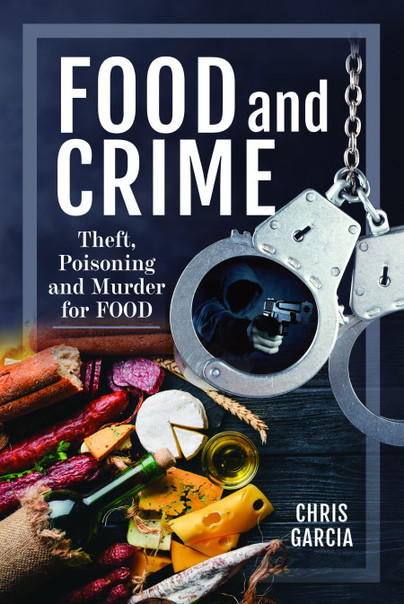Author Guest Post: Chris Garcia
4 Killer Restaurants
Restaurants have been the final destination for many people over the years. It makes sense; people are occupied with their food, they’re designed for egress, and with the movement of people in and out makes it ideal for a killer to make their way in. The controlled nature of most restaurants is also a reason a killer might choose to attack at a restaurant. May Western restaurants are designed to funnel people through specific paths in and out, making egress simple. Fast food restaurants, with their crowded nature, typically young staff and designs that typically maximize space-saving features over, have seen several mass shootings, including the San Ysidro McDonald’s shootings, covered in a full chapter of my book, Food and Crime. Many restaurants are also largely cash businesses, which makes them appealing targets for thefts that sometimes turn deadly. Some killers come to the restaurant, and others are perpetrated by current or former employees or owners. Sometimes, it’s simply a place where a crime happens, and other times the restaurant is the goal a shooter hopes to acquire.
-
The Eight Immortals Murders
Macau, a former Portuguese colony, is known as a gambling hub, and Zheng Lin and Huang Zhiheng were gamblers. In 1984, the two spent a long, drunken night playing mahjong and making wagers. By the daylights first glinting, Zheng owed 180,000 yuan, roughly 63,000 pounds in 2023, and had no way to pay him back. He promised Huang the restaurant he owned if he hadn’t completely settled the debt within a year. He made payments, but could only do so for a while. When a year passed, Huang went to collect. Zheng refused. Huang, then, took the restaurant by force.
He strangled, stabbed, and then dismembered the entire family. All ten members, ages 7 to 70.
After committing the crimes, he actually took over the restaurant, running it while pieces of the bodies washed up on Macau beaches. He ran the restaurant until he was arrested for the crimes. He had even rented out the family’s home in the days before the discovery.
A long-time urban legend says that he made buns that he filled with some of the meat taken from the bodies of his victims and sold them in the restaurant. This does seem unlikely considering how many pieces were found in dumpsters and washed ashore.
-
The Luby’s Mass-shooting
The 1990s saw mass-shootings greatly increase in the US, and fast food restaurants were the settings for several of the most deadly sprees in US history.
Killeen, Texas, October, 1991, the lunch rush was underway at the Luby’s cafeteria. At 12:39pm, George Hennard, an unemployed former merchant marine, drove his truck through the front of the crowded cafeteria, then emerged and starting shooing people while screaming anti-woman epitaphs. He had two weapons, and re-loaded at least three times, killing 23, several by shooting them at close range in the head, and injuring 27. Hennard engaged in a fire-fight with police that left him with three bullet wounds. He responded to demands to surrender with “No, I’m going to kill more people.” After the police managed to shoot him twice more in the abdomen, Hennard shot himself, finally ending the spree.
Though many have pointed to Hennard’s well-documented issues with women, no motive has ever been officially established.
At the time, it was the most deadly mass-shooting in the US in the 20th century.
-
The Brown’s Chicken Massacre.
January, 1993, Palantine, Illinois, USA. About 11pm, Michael Castro, a Brown’s Chicken & Pasta employee, hadn’t made it home, so his parents called the police. Another employee’s wife called concerned he had not come home, and mentioning that she had seen his car in the parking lot even though the restaurant had been closed for hours. Officers arrived and found the back door open. When they looked in the cooler, they found seven bodies, the owners and the five employees who had been working that evening.
There was a clue – a piece of partially eaten chicken in an otherwise empty garbage can. The chicken was collected, but no suspects were determined for more than nine years, when the ex-girlfriend of a man named James Degorski implicated him and his friend Juan Luna in the crimes. Luna had previously worked at the restaurant. The murders were not the intention – they may only have meant to take the register tills, but found they had to eliminate the witnesses.
-
The Murder of Carmine Galante
The American Mafia is one of the most significant criminal enterprises in history. Since the late 19th century, the Mafia has exerted significant control over many areas across the country, but nowhere has become as deeply associated with the American Mob as New York City. Carmine “Cigar” Galante had been a killer and drug trafficker for the Bonanno crime family since the 1940s, after years as a contract killer for the Luciano family. In 1976, after Bonanno family boss Rusty Rastelli ended up going to prison, and Galante declared himself the new head of the Bonanno crime family. This movement into leadership did not sit well with the Commission, the group which provided some regulation of the Five Families.
On July 12, 1979, Galante brought one of his most trusted capos, another Bonanno foot soldier who also owned the restaurant, and a pair of Sicilian bodyguards, to enjoy a lunch lunch on the patio at Joe & Mary’s Italian-American Restaurant in Bushwick, Brooklyn. A van pulled up, three masked gunmen jumped out, and fired on the table, killing the Bonanno family members, but leaving the bodyguards alive.
The hit, which had been authorized by the Commission after Rastelli had requested it, was widely-supported by the other families as a way of showing what happens when even the strongest of Mob members step out of their assigned roles.

Food and Crime is available to order here.

